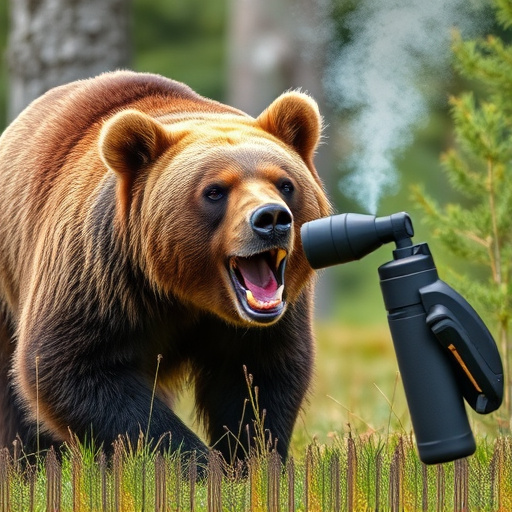Bear spray, a specialized pepper spray, offers a non-lethal defense against aggressive bears, particularly grizzlies, by creating an irritant barrier that causes them to retreat. While effective in reducing attack rates, its performance against charging grizzlies is debated, with simulations showing reduced charge speed but no guaranteed defense. The key ingredient capsaicin creates a burning sensation, temporarily disorienting the bear. Proper usage involves keeping spray accessible, staying calm, assessing the bear's behavior, and targeting sensitive areas from around 20-30 feet away. Combining bear spray with awareness and safety equipment is crucial due to the unpredictable nature of bear encounters.
In areas where grizzlies roam, knowing how to defend yourself is crucial. This guide explores bear spray as a key tool in deterring charging grizzly bears. We’ll delve into the science behind bear spray, understanding why and how it works. Comparing its efficacy with other methods, we analyze scenarios of bear encounters and provide best practices for safe usage. By armed with knowledge, you can navigate bear country more confidently, knowing your defenses against these formidable predators.
- Understanding Bear Spray: The Basics and How It Works
- Charging Grizzly Bears: Behavior, Motives, and Risks
- Efficacy of Bear Spray in Deterring Charges
- Best Practices for Using Bear Spray as a Defense
Understanding Bear Spray: The Basics and How It Works
Bear spray, also known as bear repellent, is a valuable tool for individuals venturing into bear country. It’s a specialized pepper spray designed to protect against aggressive bears, particularly grizzlies. When deployed, bear spray creates a protective barrier, irritating the bear’s eyes and nasal passageway, causing it to retreat.
Unlike direct confrontation or running away, which can trigger a chase response in charging grizzlies, bear spray offers a non-lethal means of self-defense. It works by deterring bears through scent and sensory irritation, allowing individuals time to escape or de-escalate the situation. Understanding how bear spray functions is crucial for anyone planning outdoor activities in areas inhabited by these majestic yet potentially dangerous animals, especially when comparing its effectiveness to other defensive measures like speed or direct aggression.
Charging Grizzly Bears: Behavior, Motives, and Risks
Charging Grizzly bears are a significant concern for outdoor enthusiasts and individuals living in bear country. These powerful animals can charge at speeds up to 35 mph (56 km/h), making them formidable opponents. When a grizzly bears charges, it’s typically driven by three primary motives: protecting its young, defending its food source, or establishing territorial dominance. However, understanding these behaviors is crucial when considering bear spray as a defense mechanism.
While bear spray can be an effective deterrent against many predators, its effectiveness against a charging grizzly bear is debatable. Direct comparison studies are limited, but simulations suggest that bear spray may reduce charge speed and alter the bear’s behavior. However, it’s essential to remember that no single method guarantees 100% protection against a determined charger. Bear spray vs. charging grizzly involves factors like spray range, wind conditions, and individual bear aggression, making it a complex scenario for outdoor adventurers to navigate.
Efficacy of Bear Spray in Deterring Charges
Bear spray has emerged as a popular defense mechanism for individuals encountering predators, particularly grizzlies. When faced with an imminent charge, the spray’s effectiveness in deterring attacks cannot be overstated. The key active ingredient, capsaicin, creates a burning sensation in the eyes and respiratory system of bears, temporarily disorienting them and allowing victims to escape. Studies have shown that bear spray can significantly reduce attack rates, especially when used correctly at close range.
Comparatively, bear spray offers a more efficient solution than physical barriers or noise makers against charging grizzlies. While loud noises may startle some bears, they are less likely to alter the animal’s behavior during an aggressive charge. Bear spray, on the other hand, directly targets the bear’s senses, providing a quicker response and higher chances of escaping unharmed. This advantage is especially crucial when dealing with larger grizzly bears, known for their strength and ferocity.
Best Practices for Using Bear Spray as a Defense
When faced with a charging grizzly or other predatory bear, using bear spray as a defense requires understanding best practices. Firstly, ensure your spray is easily accessible—within reach and ready to deploy. Secondly, stay calm and assess the bear’s behavior; aim for the face and eyes, targeting sensitive areas to deter the attack without endangering lives unnecessarily. Practice proper application techniques: hold the can upright, spray in short bursts at close range (around 20-30 feet), and follow up with a second or third burst if needed. Remember, bear spray is most effective as a deterrent; your primary goal should be to escape the immediate situation.
In comparison to a charging grizzly, bear spray offers a strategic advantage when used correctly. While a grizzly’s powerful build and sharp claws make direct confrontation dangerous, bear spray can create enough distance and disorient the bear long enough for you to retreat safely. However, it’s crucial to understand that no single defense mechanism is foolproof against an aggressive predator; carry appropriate safety equipment, stay aware of your surroundings, and always prioritize escaping the situation rather than confronting the bear directly.
In conclusion, bear spray can be an effective defense against charging grizzlies, but its success depends on understanding both the product and predator. When used correctly, it provides a valuable tool for outdoor enthusiasts in the great wilderness. However, no single method guarantees safety during encounters with these powerful animals. It’s crucial to remember that knowledge of bear behavior, proper usage techniques, and staying prepared are key when navigating Bear Spray vs. Charging Grizzly situations.
